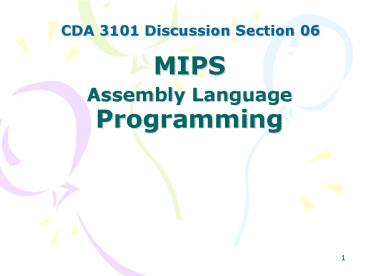MIPS Assembly Language Programming PowerPoint PPT Presentation
1 / 6
Title: MIPS Assembly Language Programming
1
MIPS Assembly Language Programming
CDA 3101 Discussion Section 06
2
Problem 1
- Write a function MinMax(X, N) to find the
minimum and - maximum of an array X of N integers. The address
of the - array is passed in a0, and the number of words
in the array - is passed in a1. The minimum and maximum are
returned in - registers v0 and v1 respectively.
- Also, write a short main program that
- Prompts the user for the value of N.
- Dynamically allocates memory for storing array X
of N integers. (Remember, 4 bytes per integer!) - Prompts user to enter N integers one by one to
fill the array X. - Calls the MinMax function to find and return the
minimum and maximum of the array X. - Prints the minimum and the maximum value.
3
Problem 1
- Write a function MinMax(X, N) to find the
minimum and - maximum of an array X of N integers. The address
of the - array is passed in a0, and the number of words
in the array - is passed in a1. The minimum and maximum are
returned in - registers v0 and v1 respectively.
- Also, write a short main program that
- Prompts the user for the value of N.
- Dynamically allocates memory for storing array X
of N integers. (Remember, 4 bytes per integer!) - Prompts user to enter N integers one by one to
fill the array X. - Calls the MinMax function to find and return the
minimum and maximum of the array X. - Prints the minimum and the maximum value.
4
Problem 2
- Implement a recursive function fib(n) to compute
Fibonacci numbers. Also write a short main
function that prompts the user to enter the
integer N, calls the function fib(N) and prints
the value returned by the fib(N) function.Note
that - fib(0)0 fib(1)1
- fib(n)fib(n-1) fib(n-2), ngt1.
5
Problem 2
- Implement a recursive function fib(n) to compute
Fibonacci numbers. Also write a short main
function that prompts the user to enter the
integer N, calls the function fib(N) and prints
the value returned by the fib(N) function. - int fib(int N)
- if(N 0) return 0
- else if(N 1) return 1
- else return fib(N-1) fib(N-2)
6
Key Points
- Dynamically allocate memory
- li v0, 9 Memory allocation service
- li a0, ltintgt Allocate ltintgt bytes of
mem. - syscall
- move t0, v0 Move address of array to
safety. - Recursion
- self
- addi sp, sp, -4 Allocate stack space
- sw ra, 0(sp) Save old return
address - jal self Jump to self
- lw ra, 0(sp) Load old return address
- addi sp, sp, 4 Restore stack to old state

